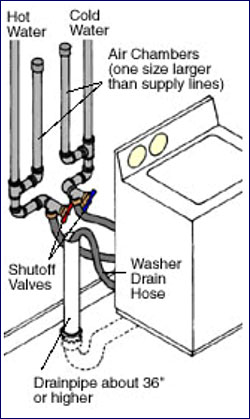Replacing a clothes washer is relatively simple. Contemporary clothes washers will fit neatly into a 27- to 30-inch-wide space between counters or freestanding in your basement or laundry/utility room.
Usually, clothes washers are wired and ready to be attached to existing water supply, drainage and electrical hookups.
Installing a clothes washer where there are no existing hook-ups, however, is a much a larger job. You must not only make room for the new unit, but also plan how to bring in electrical power, as well as water supply and drain lines.

Examining the plumbing of your old clothes washer will help make the installation of your new clothes washer easier.
Follow these steps for your installation:
Step 1. Turn off the Water and Electricity
To replace an existing machine, unplug the power supply, and then close the hot- and cold-water shutoff valves. The shut-off valves for your clothes washer should be located near the machine. Before installing a new clothes washer, if you’ll need some wiring done, also shut off the electrical circuit to the area.
Step 2. Prepare the Openings
Next, for an existing machine, disconnect the hot and cold water supply lines, and the drain hose. For a first-time installation, carefully plan the location of the clothes washer. Ideally, you should find a level spot near existing water supply and drain lines, and electrical power.
Step 3. Supply Electricity
Although modern washing machine motors are typically protected against thermal overload, your washer should be connected to its own properly grounded and protected 15 amp fuse or electrical circuit. This will protect your circuits from overload, which occurs when too many appliances or fixtures are running simultaneously on a single line. For a first-time installation, run a dedicated line from the service panel to an electrical box wall-mounted near the back of the clothes washer (Fig. 1). Clothes washers typically require a 120 volt 60 hertz electrical outlet. You may want to hire a licensed electrician to do this job.
Step 4. Install New Water Lines
For a first-time installation, run new branch lines for hot and cold water supply to the wall near where you plan to put the clothes washer, and then install a shutoff valve on each line. (It is possible to get a ball valve with a lever that shuts off both lines at once). Temporarily cap the lines, and then turn on the water to test for leaks. If you do not have experience installing new pipes, you should hire a licensed plumber for this task.
Step 5. Install a Branch Drain
For a first-time installation, you will need to tap into your existing drainage and venting system. To prevent back flow when your clothes washer is draining, the machine’s flexible drain hose must, by code, empty into a drain trap at least 1-1/2 inches in diameter. The drainpipe must extend at least 36 inches above floor level, and the trap itself should be below floor level.
Step 6. Attach the Drain Hose
Whether you’re replacing a machine or installing a new one, attach the flexible drain hose to the clothes washer’s drain outlet, and then carefully insert the other end into the drainpipe opening. Secure it in place with a vented conversion fitting.
Step 7. Hook up the Water Supply
For either type of installation, attach the water supply hoses to the unit’s water supply outlets. Use a wrench, slowly tightening the nuts and washers. Repeat this step on the other end of the hose as you hookup the supply hoses to the water supply lines.
Step 8. Make Electrical Connections
If the washer is a replacement, plug the machine into the existing outlet. For a new installation, wire a dedicated 15 amp electrical circuit to a receptacle box (see Step 3, above), and then wire the receptacle. Test the circuit for power, attach the cover plate, and then plug in the washer unit.
Step 9. Level the Unit
Set the clothes washer into final position. Level the machine by adjusting the leveling legs. Turn the water on at the shutoff valves, and then switch on the electrical power. Run the washer, checking it carefully for leaks.
- What to Do if Your House Smells Like Gas but There’s No Leak - February 6, 2023
- Why Is There a Burning Smell Coming From My Vents? - August 16, 2022
- How to Remove the Musty Smell From Your Air Conditioner - August 16, 2022

Bettina Irving
Sunday 24th of October 2021
Your instructions of installing hook ups for a washing machine are very well written. Thank you.